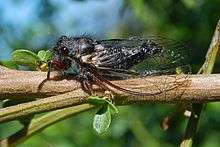Platypedia
Platypedia is a genus of cicadas in the family Cicadidae. There are more than 20 described species in Platypedia.[1][2][3]

Platypedia putnami
| Platypedia | |
|---|---|
 | |
| Platypedia minor | |
| Scientific classification | |
| Kingdom: | Animalia |
| Phylum: | Arthropoda |
| Class: | Insecta |
| Order: | Hemiptera |
| Superfamily: | Cicadoidea |
| Family: | Cicadidae |
| Genus: | Platypedia Uhler, 1888 |
Species
These 24 species belong to the genus Platypedia:
- Platypedia affinis Davis, 1939
- Platypedia aperta Van Duzee, 1915
- Platypedia areolata (Uhler, 1861) (salmonfly)
- Platypedia australis Davis, 1941
- Platypedia balli Davis, 1936
- Platypedia barbata Davis, 1920
- Platypedia bernardinoensis Davis, 1932
- Platypedia falcata Davis, 1920
- Platypedia gressitti Kato, 1932
- Platypedia intermedia Van Duzee, 1915
- Platypedia laticapitata Davis, 1921
- Platypedia mariposa Davis, 1935
- Platypedia middlekauffi Simons, 1953
- Platypedia minor Uhler, 1888
- Platypedia mohavensis Davis, 1920
- Platypedia primigenia Cockerell & T.D.A., 1908
- Platypedia putnami (Uhler, 1877)
- Platypedia rufipes Davis, 1920
- Platypedia scotti Davis, 1935
- Platypedia similis Davis, 1920
- Platypedia sylvesteri Simons, 1953
- Platypedia tomentosa Davis, 1942
- Platypedia usingeri Simons, 1953
- Platypedia vanduzeei Davis, 1920
gollark: The important thing is probably... quantitative data about the amounts and change of each?
gollark: Regardless of what's actually happening with news, you can probably dredge up a decent amount of examples of people complaining about being too censored *and* the other way round.
gollark: With the butterfly-weather-control example that's derived from, you can't actually track every butterfly and simulate the air movements resulting from this (yet, with current technology and algorithms), but you can just assume some amount of random noise (from that and other sources) which make predictions about the weather unreliable over large time intervals.
gollark: That seems nitpicky, the small stuff is still *mostly* irrelevant because you can lump it together or treat it as noise.
gollark: Why are you invoking the butterfly effect here?
References
- "Platypedia Report". Integrated Taxonomic Information System. Retrieved 2019-09-23.
- "Platypedia". GBIF. Retrieved 2019-09-23.
- "Platypedia genus Information". BugGuide.net. Retrieved 2019-09-23.
Further reading
- Simons, John N. (1953). "New California cicadas with taxonomic notes on other species (Homoptera: Cicadidae)". Pan-Pacific Entomologist. 29 (4): 191–198. ISSN 0031-0603.
- Sanborn, A. F.; Phillips, P. K. (2013). "Biogeography of the Cicadas (Hemiptera: Cicadidae) of North America, North of Mexico" (PDF). Diversity. 5 (2): 166–239. doi:10.3390/d5020166.
- Sanborn, Allen F. (2009). "Checklist, new species and key to the cicadas of Cuba (Hemiptera, Cicadoidea, Cicadidae)". Deutsche Entomologische Zeitschrift. 56 (1): 85–92. doi:10.1002/mmnd.200900007.
- Moulds, M. S. (2012). "A review of the genera of Australian cicadas (Hemiptera: Cicadoidea)" (PDF). Zootaxa. 3287 (1): 1. doi:10.11646/zootaxa.3287.1.1. ISBN 978-1-86977-890-3.
- Popple, L. W. "The cicadas of Australia". Retrieved 2019-07-02.
- Moulds, M. S. (2005). "An Appraisal of the Higher Classification of Cicadas (Hemiptera: Cicadoidea) with Special Reference to the Australian Fauna" (PDF). Records of the Australian Museum. 57 (3): 375–446. doi:10.3853/j.0067-1975.57.2005.1447.
- Sanborn, Allen (2013). Catalogue of the Cicadoidea (Hemiptera: Auchenorrhyncha). Academic Press. ISBN 9780124166479.
- Moulds, M. S. (2018). "Cicada fossils (Cicadoidea: Tettigarctidae and Cicadidae) with a review of the named fossilised Cicadidae". Zootaxa. 4438 (3): 443–470. doi:10.11646/zootaxa.4438.3.2. PMID 30313130.
This article is issued from Wikipedia. The text is licensed under Creative Commons - Attribution - Sharealike. Additional terms may apply for the media files.